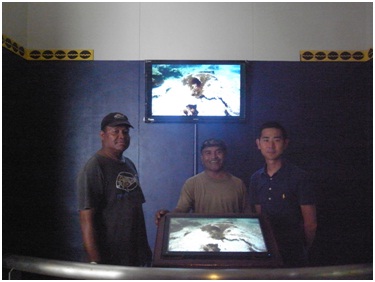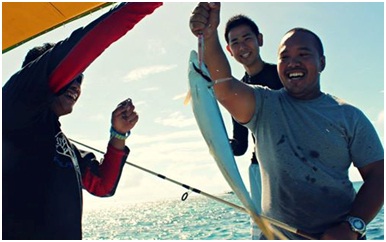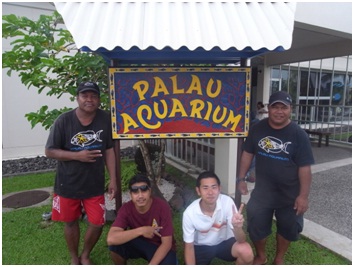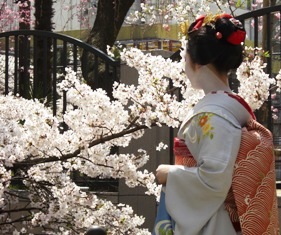JICA Volunteers in Palau
◆Alii from Palau!
Mr. Yoshihisa Goto
JICA Volunteer
Palau International Coral Reef Center
My workplace is an aquarium located within the Palau International Coral Reef Center (PICRC). PICRC is a research institution constructed by Japan’s grant aid in 2001. The purpose of the center is to conduct research on Palau’s coral reefs and surrounding ecosystems as well as to educate and advocate the public of environmental conservation.
I am dispatched as a Private Company Partnership Volunteer* in order to improve visual facilities in the aquarium and to enrich their contents. To achieve these missions, I have introduced an interactive touch panel facility and am currently creating new contents such as quizzes for environmental education to protect corals and displays of research projects conducted by PICRC’s research team.

(Newly installed touch panel)
PICRC conducts joint research with overseas universities and accepts internships and volunteers. Therefore, I communicate with people with different cultural backgrounds every day, not to mention with Palauan people. It is a precious opportunity for me to communicate with them and understand their values, which is not easy to experience in my company back in Japan. I am very appreciative that I can volunteer in this significant environment.
I would like to briefly introduce the ecology of corals as the aim of my volunteer work is to make as many people as possible understand and be interested in the importance of corals and marine creatures. Corals belong to a cnidarians group together with sea anemones and jelly fish. As a cnidarian, they have stinging cells in their tissue and some species cause sharp pain to those who touch them. I myself have experienced the pain several times after making contact with corals. Corals live in symbiosis with zooxanthellae, a species of algae. Zooxanthellae produce oxygen and nutrition such as sugar and amino acids for corals to grow. Recently, there is much public attention on coral bleaching, a phenomenon in which the decrease of these zooxanthellae leads to the death of corals due to the depleted oxygen and nutrition.
Why then is it a problem if corals die? It is because collected data says coral reefs consist one-sixth of the world’s coastlines, hosts 25% of ocean fish species, and produces 10% of fish catch. Its economic value is believed to be worth $30 billion. Coral reefs also provide a suitable environment for shelter, reproduction and upbringing for 25% of ocean fish species, as well as food for some fish such as parrot fish and surgeonfish. Therefore, the death of corals is a major problem for creatures living on them. Although juvenile, young and small fish would primarily face the direct impact, this impact would eventually affect large-sized fish at the top of the food chain, such as tunas and sharks.

(Collecting fish for aquarium)
Many have stereotyped sharks as vicious animals that attack people, but only around 10 people are actually attacked by sharks annually compared to 150 people injured by fallen coconuts, according to statistics from Florida University. It is an ironic fact that coconuts with its refreshing image are more dangerous than seemingly fierce sharks. Palau is the first nation in the world to introduce the Shark Sanctuary. I observe a number of sharks during my dive research, but I have never been attacked. Seventy million sharks are said to be caught by people for food, such as for shark fins soup. We should know that sharks are the true victims before feeling fear towards sharks.
I mentioned above that we have to protect corals because it is critical for ocean fish species. Then, how can we protect corals? There are several reasons why corals die: bleaching, sedimentation, natural enemy like crown-of-thorns, physical destruction, and natural disaster like typhoons. It is still unknown which factor has the largest influence, which makes effective protection difficult.
Facing this difficulty, researchers all over the world are conducting ecological and environmental research to preserve the world’s corals. Japanese researchers from the University of the Ryukyus and the Tokyo Institute of Technology also implement a project called P-CORIE to conduct monitoring and research on coral reefs jointly with PICRC with funding from JICA.

(With My Colleagues at PICRC)
I have also committed myself in PR to communicate these research contents to the public in a simple and easy way. During the short time left in my mission, I will work on improving displays and facilities to make guests and local residents feel attached to the marine environment of Palau and become interested in environmental protection.
*In JICA’s Private Company Partnership Volunteer program, Japanese private companies provide their employees to be dispatched to the world as volunteers. While the technical expertise of these volunteers contributes largely to developing countries, the company also benefits from their employees gaining a global perspective and capacity through their volunteer works.
©Embassy of Japan in the Republic of Palau
P.O. Box 6050 Koror, Republic of Palau 96940

